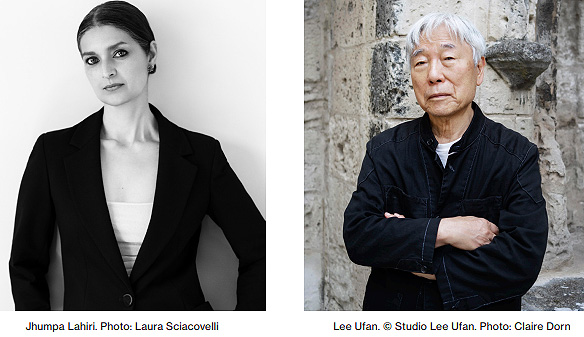이우환, 줌파 라히리 2024 이사무노구치상 수상

Jhumpa Lahiri and Lee Ufan to Receive 2024 Isamu Noguchi Award
The 11th annual Isamu Noguchi Award will be presented at The Noguchi Museum’s fall benefit on October 29, 2024
New York (July 1, 2024) — The Isamu Noguchi Foundation and Garden Museum — the first museum in the United States to be established, designed, and installed by a living artist to show their own work— announces the recipients of the 11th annual Isamu Noguchi Award. The Award will be presented at The Noguchi Museum’s fall benefit on Tuesday, October 29, 2024, at The Noguchi Museum in Long Island City, New York. The 2024 Isamu Noguchi Award will recognize
Pulitzer Prize-winning novelist, translator, and short story writer Jhumpa Lahiri and artist, philosopher, writer, and poet Lee Ufan. The Isamu Noguchi Award honors highly accomplished individuals who embody Noguchi’s innovative spirit, limitless imagination, and unwavering dedication to creativity. Presented annually, the Award highlights how Noguchi’s principles continue to influence contemporary culture, as demonstrated by the work of the honorees.
The Noguchi Museum’s annual benefit raises essential funds to support its exhibitions, research, and programming, and the care of its renowned collection.
“We are delighted to honor Jhumpa Lahiri and Lee Ufan with the 2024 Isamu Noguchi Award,” says Director of The Noguchi Museum Amy Hau. “Both recipients exemplify the innovative spirit and commitment to cross-cultural dialogue that Noguchi championed throughout his life. Lahiri’s Jhumpa Lahiri and Lee Ufan to Receive 2024 Isamu Noguchi Award The 11th annual Isamu Noguchi Award will be presented at The Noguchi Museum’s
fall benefit on October 29, 2024
Jhumpa Lahiri. Photo: Laura Sciacovelli Lee Ufan. © Studio Lee Ufan. Photo: Claire Dorn poignant literary explorations and translations of identity and belonging, alongside Ufan’s profound contributions to contemporary art and philosophy, resonate deeply with Noguchi’s vision of art as a
bridge between diverse cultural and temporal landscapes. Their work not only enriches the arts, but also reinforces Noguchi’s belief in the power of creativity to transform and unify our world.”
The quintessential sculptor in an expanded field, Isamu Noguchi (1904–1988) was a future-focused idealist whose timeless work blended the ancient and the modern; formalism and conceptualism; and art, architecture, and design. His multidisciplinary approach and ability to bridge many of the supposedly irreconcilable contradictions at the center of contemporary life — such as the one between traditional cultures and technological innovation — remain an inspiration for a wide range of creative people. Using all that he learned designing playgrounds, dance sets and gardens, he remade sculpture into a discipline for understanding our place in the universe and a technique for integrating the best habits and effects of craft into daily life.
The Award celebrates individuals from around the world, across various disciplines, whose works exemplify the highest level of artistic integrity, characterized by fearless experimentation and a commitment to cross-cultural dialogue and exchange. Honoring those whose work embodies the artistic excellence shared with Noguchi, the Award also recognizes contributions that carry significant social consciousness and functionality.
HONOREES
Jhumpa Lahiri, British-American, Pulitzer Prize-winning author of Interpreter of Maladies, is renowned for her exploration of immigrant experiences and identity struggles through elegant prose. Her acclaimed works, including The Namesake, Unaccustomed Earth, The Lowland, In Other Words, and Whereabouts, showcase her storytelling in both English and Italian. In addition to numerous literary awards, Lahiri has translated notable Italian works and currently serves as the Millicent C. McIntosh Professor of English and Director of Creative Writing at Barnard College.
Both Lahiri and Noguchi navigate the complexities of identity and belonging across cultures. Lahiri’s stories delve into the immigrant experience and the search for identity and home, and as with Noguchi’s life and art, blend Eastern and Western influences. Lahiri’s fearless experimentation with language and narrative forms mirrors Noguchi’s innovative ability to transcend boundaries and mediums through art and design.
Lee Ufan, currently based in Japan and France, was born in Korea in 1936. He graduated from Nihon University, Department of Philosophy, in Tokyo in 1961 and served as Professor Emeritus at Tama Art University. He is one of the leading figures of Mono-ha (School of Things), a contemporary art movement emerging in the late 1960s. Lee Ufan and Isamu Noguchi share a deep connection through their minimalist aesthetics, use of natural materials, and philosophical depth.
Both artists explore the interaction between their work and the surrounding space, emphasizing simplicity and natural harmony. Their works reflect a profound respect for nature and cultural hybridity, contributing to a deeper understanding of art’s relationship with the natural world and human experience.
*이우환 Open Dimention@허쉬혼뮤지엄, DC, 2019
ABOUT THE ISAMU NOGUCHI AWARD
Established in 2014 and presented annually, The Isamu Noguchi Award acknowledges highly accomplished individuals who share Noguchi’s spirit of innovation, unbounded imagination, and uncompromising commitment to creativity. The Award celebrates individuals from around the world, across various disciplines, whose works demonstrate the highest level of artistic integrity marked by fearless experimentation and a preoccupation with cross-cultural dialogue and exchange. Honoring creatives whose work exhibits qualities of artistic excellence that are shared with Noguchi, the Award also recognizes work that carries significant social consciousness and function. The two inaugural recipients were architect Lord Norman Foster and artist Hiroshi Sugimoto. Following this, in 2015, the Museum honored industrial designer Jasper Morrison and architect Yoshio Taniguchi; in 2016, architect Tadao Ando and sculptor Elyn Zimmerman; in 2017, architect John Pawson and artist Hiroshi Senju; in 2018, industrial designer Naoto Fukasawa and landscape designer Edwina von Gal; in 2019, fashion designer Rei Kawakubo; in 2020, architect Sir David Adjaye OBE and artist Cai Guo-Qiang; in 2021, artist Shio Kusaka and architect Toshiko Mori; in 2022, artist Daniel Brush and sculptor Thaddeus Mosley; and in 2023, artist and writer Edmund de Waal, artist Theaster Gates, and novelist and editor Hanya Yanagihara.




 블룸버그재단 10억달러 기부, 존스홉킨스 의대생 등록금 무료
블룸버그재단 10억달러 기부, 존스홉킨스 의대생 등록금 무료
 단색화 전문학자 조안 키(Joan Kee) NYU 파인아트인스티튜트(IFA)...
단색화 전문학자 조안 키(Joan Kee) NYU 파인아트인스티튜트(IFA)...

